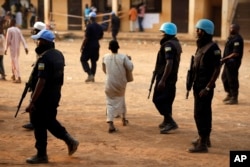A U.N. report on the increase in peacekeepers killed in violent attacks blames many of the fatalities on inaction in the field and "a deficit of leadership'' from U.N. headquarters to remote locations.
It urges greater initiative, determination, action and use of force when necessary.
"Nobody attacks a stronger opponent,'' the authors say.
The report released Monday was authorized by Secretary-General Antonio Guterres and funded by China. It was led by retired Brazilian Lt. Gen. Carlos Alberto dos Santo Cruz, a former commander of U.N. peacekeepers in Haiti and Congo, and retired U.S. Army Col. William Phillips, a former chief of staff in the peacekeeping mission in Mali.
"Casualties have spiked'' since 2013, the report said, with 135 soldiers, police and civilians in the U.N.'s 15 far-flung peacekeeping missions killed by acts of violence - "more than during any other five-year period in history.''
There were at least 56 fatalities in 2017 - "the highest number since 1994,'' it said.
"These numbers go beyond a normal or acceptable level of risk, and they are likely to rise even higher,'' the report warned about security for the more than 100,000 U.N. peacekeepers.
The 35-page paper said the U.N. and countries contributing soldiers and police to peacekeeping missions "need to adapt to a new reality: The blue helmet and the United Nations flag no longer offer 'natural protection.'''
"Peacekeeping environments now feature armed groups, terrorists, organized crime, street gangs, criminal and political exploitation and other threats,'' it said.
But, it added, the U.N. and governments participating in such missions are "still gripped'' by a mindset that shies from the use of force.
The missions' mandates, rules of engagement and other documents "should support taking action, and not be used to justify inaction,'' the report said.
"Fatalities rarely occur as a result of troops and leadership taking action: The United Nations is most often attacked as a result of inaction,'' it said. "In battles and in fights, the United Nations needs to win, or troops, police and civilian personnel will die.''
Peacekeepers "must perform,'' the authors said, and the U.N. should not accept conditions from contributing nations on when the troops act because that weakens the missions and "increases the risk of casualties.''
According to the report, in the 69 years since the first peacekeeping mission was deployed in 1948 there have been 943 peacekeeper deaths "due to malicious acts'' - with three periods of significant increases in fatalities.
The first was about 1960-62 and included deployments in Suez and Congo. The second in 1992-96 included U.N. missions in Rwanda, Somalia, Cambodia and the Balkans. The third began in 2011, "became critical in 2013'' and continued in 2017, the report said.
During the current upsurge, the overwhelming number of fatalities occurred in the joint U.N.-African Union mission in Darfur and the U.N. missions in Mali, South Sudan and Central African Republic, the report said.









